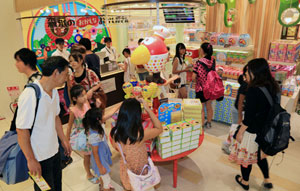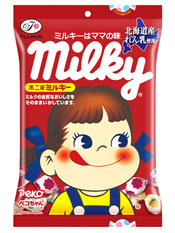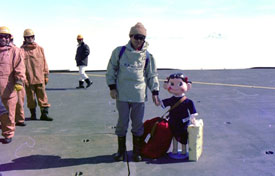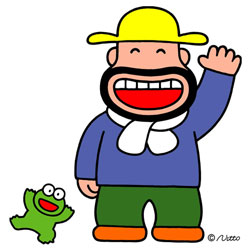
Choosing candy at Tokyo Okashi Land, a new attraction in Tokyo Station.
Japanese candy shops are a paradise for kids, decorated with bright colors and full of fun pack designs. Candy is often made into tiny plants and animals only a few centimeters tall that looks really cute. These intricate and typically Japanese designs look astonishingly real. There is a real sense of fun in snacks made to look like various marine creatures such as prawns, squid, and fugu pufferfish or chocolate-coated biscuit like toy bamboo sprouts and chocolate-cracker mushrooms.
The taste and texture of Japanese candies are constantly being improved and revamped. Salt puffs were first launched in 1964 and more than 70 new flavors have been rolled out since then, based on regional Japanese cuisine or flavors used in Korean and Thai food. The development of new chocolate flavors has also resulted in new manufacturing methods that allow manufacturers to produce chocolate-soaked cereal snacks or richly flavored oven-baked products.
Japanese Snacks Popular Worldwide
One of the most famous Japanese snacks is the fine pretzel stick coated in chocolate, which first hit the shelves in 1966. The manufacturers left 3cm of the stick uncoated with chocolate so consumers did not get sticky hands, which was a real novelty at the time. Apparently the first products were made by hand because the manufacturers could not automate this process. These snacks are now made in four different countries and over 500 million packs are sold each year in more than 30 countries worldwide.

The ever-popular Pocky (or MIKADO in Europe) — worldwide around 500 million packs sell each year. © Ezaki Glico Co.
Japanese snacks and candies come in a wide range of tastes and textures. Even the chocolate-dipped pretzel sticks come in different types. You can get sticks coated with cream containing real strawberry fruit instead of chocolate, or chocolate with almond bits, or sweetly fragrant sticks with bran mixed into the coating. Over 100 different types have been launched to date. There are even flavors aimed at adults, such as a new product with melt-in-the-mouth chocolate targeted at women in their 30s and 40s. Japanese snack makers are working to create products that will be loved by people of all ages, using creative new ideas and different tastes and textures.
Candies with Characters
Just looking at a pack of candy can make one's mouth water, but companies also use famous characters on packaging to increase product appeal.
One of the most famous characters in Japan is Peko-chan, a cute 6-year-old girl with pigtails and her tongue poking out who is used as a mascot on Milky candies. Peko-chan first made an appearance in 1950. This 1-meter tall little girl in overalls quickly became a nationwide hit and her image could be seen not only on candy packaging, but also on magazine covers and in road safety campaigns. In 1976, a Peko-chan statue was sent to an Antarctic base on the request of a Japanese Antarctic observation team. The statue was stood in the base dining hall to cheer the researchers with her happy smile during the long winter months.
 |
 Left: The character Peko-chan has been a national star for 62 years. © FUJIYA CO., LTD
Left: The character Peko-chan has been a national star for 62 years. © FUJIYA CO., LTDRight: The Peko-chan statue with the Antarctic observation team. (January 8, 1976) |

Uncle Karl, promoted from a minor role in a Meiji Co. snack commercial to the main character.
Another famous character used to promote snacks in Japan is Uncle Karl, a bearded farmer that everyone in Japan is familiar with. Uncle Karl was first used in an animated commercial in 1974. The character only had a minor role in that first commercial, following along behind some children eating snacks before falling into a river, but he became popular for his innocent face and funny antics, so he was promoted to the main role. Today Uncle Karl is the main brand character for the snack company itself.